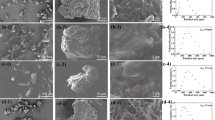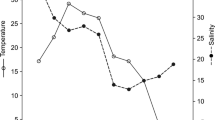Abstract
The purpose of the present study is to develop a new conductive coating for application on fishing nets that can be used as an anode, while submersed in the sea, to generate free chlorine which will in turn inhibit marine biofouling. To confirm the durability and viability of this coating, long-term field tests were carried out in the Nanao harbor in Taiwan. Electrical resistivity tests showed that polyurethane resin with carbon black and graphite can demonstrate the lowest resistivity: 0.06 Ωm. This sample also generated optimal quantities of free chlorine, which performs excellent antifouling properties. The use of carbon black in conjunction with graphite did prove to yield greater benefits. A 500-day field test showed that the PU-CG conductive coatings reduced the quantity of marine biofouling attached to the cage by approximately 79%. Furthermore, the chlorine produced was within safe levels, and judged not to pollute the sea. However, this antifouling system still shows durable problems which remain to be considered.










Similar content being viewed by others
References
Alzieu C (1991) “Environmental Problems Caused by TBT in France: Assessment, Regulations, Prospects”, Marine Environmental Research 32:7–17. doi:10.1016/0141-1136(91)90029-8
Regoli L, H M Chan, Y de Lafontaine and I Mikaelian (2001) “Organotins in Zebra Mussels (Dreissena Polymorpha) and Sediments of the Quebec City Harbour Area of the St. Lawrence River”, Aquatic Toxicology 53:115–126. doi:10.1016/S0166-445X(00)00174-0
Hodson S L, C M Burke, and A P Bissett (2000) ”Biofouling of Fish-cage Netting: The Efficacy of a Silicon Coating and Effect of Netting Colour”, Aquaculture, 184:277–290. doi:10.1016/S0044-8486(99)00328-2
Champ MA (2003) ”Economic and Environmental Impacts on Ports and Harbors from Convention to Ban Harmful Marine Anti-fouling System”, Marine Pollution Bulletin 46:935–940. doi:10.1016/S0025-326X(03)00106-1
Swain G W, J R Griffith, J D Bultman, H L Viencent. (1992) “The Use of Barnacle Adhesion Measurements for Field Evaluation of Non-toxic Foul Release Surfaces”, Biofouling, 6:105–114.
Lewis, JA, “Biofouling and Fouling Protection: A Defense Perspective.” In: Kjelleberg, S, Steunberg, P (eds.) Biofouling: Problems and Solutions, Proceedings of an International Workshop, pp. 39–43. The University of New South Wales, Sydney, Australia (1994)
Lindner E ((1994)) “Low Surface Free Energy Fouling Resistant Coatings” In: Thompson M F, Nagahushananm R, Sarojini R, Fingerman M (Eds) Rencent Developments in Biofouling Control, A A Balkma, Rotterdam, 305–319.
Chiang W C, S D Chyou, R Huang and J K Wu (2000) “Control of Marine Biofouling by Conductive Coatings”, Corrosion Prevention and Control 47(4):121–128.
Goodman P D (1987) “ Effect of Chlorination on Materials for Sea Water Cooling Systems: A Review of Chemical Reactions”. British Corrosion Journal 22:56–62.
Gundersen R, B Johansen, P O Gartland, L Fiksdal, I. Vintermyri, R. Tunold and G Hagen (1991) “The Effect of Sodium Hypochlorite on the Electrochemical Properties of Stainless Steels in Seawater with and without Bacterial Films”, Corrosion 47:800–807.
Valensi, G, Deltomb, E, de Zoubon, N, Vanlengenhaghe, C, Pourbaix, M, “Chlorine.” Atlas of Electrochemical Equilibria in Aqueous Solutions, pp. 590–603. NACE, Houston, TX (1974)
Oldfield J W, B Todd, (1981) “Corrosion Problems Caused by Bromine Formation in MSF Desalination Plants”. Desalination 38:233–246. doi:10.1016/S0011-9164(00)86070-1
Nishi A, M Usami, K Ueda and K Tomoshige (1992) “Antifouling System for Ship Hull by Electro-conductive Coating” Mitsubishi Heavy Ind. Tech. Rev. 29:30–35.
Environmental Protection Administration, Taiwan, 2006. Environmental Law. Published on the World Wide Web at http://law.epa.gov.tw/en/
Acknowledgment
The authors are grateful to Mr. Wen-Chi Chiang, Mr. Shang-Ju Liu, and Mr. Chien-Chung Chen who participated in this study together.
Author information
Authors and Affiliations
Corresponding author
Rights and permissions
About this article
Cite this article
Huang, JR., Lin, WT., Huang, R. et al. Marine biofouling inhibition by polyurethane conductive coatings used for fishing net. J Coat Technol Res 7, 111–117 (2010). https://doi.org/10.1007/s11998-008-9151-3
Published:
Issue Date:
DOI: https://doi.org/10.1007/s11998-008-9151-3




